UWF Digging For The Past In Molino; 2,000 Year Old Artifacts Found
June 29, 2009
Archaeologists from the University of West Florida are hard at work this summer uncovering the past in Molino, looking hard for a mission settlement dating back to the 1750’s. So far, they have not found definitive evidence of the village, but they have uncovered evidence of prehistoric life in Molino.
The Pensacola Colonial Frontiers Survey Field School, led by archaeologist John Worth, centers on the search for outlying communities associated with Pensacola’s three Spanish presidios including Native American villages and farmsteads. The students are searching an area along and near the Escambia River in Molino for a missions settlement that is believed to have included a Spanish missionary church and a small Apalachee Indian village.
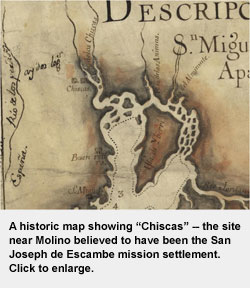 The Mission San Joseph De Escambe was established upriver along the Escambia River — which actually took its later name from the mission near Molino. The Apalachee Indian settlement with about 75 residents is well documented, according to archaeologist John Worth. It was established in the 1740’s. A Franciscan missionary was stationed by the Spanish at the village along with 15 members of a Spanish cavalry unit until about 1757.
The Mission San Joseph De Escambe was established upriver along the Escambia River — which actually took its later name from the mission near Molino. The Apalachee Indian settlement with about 75 residents is well documented, according to archaeologist John Worth. It was established in the 1740’s. A Franciscan missionary was stationed by the Spanish at the village along with 15 members of a Spanish cavalry unit until about 1757.
The village was led by Apalachee Chief Juan Marcos Fant until it was destroyed during a Creek Indian raid on April 9, 1761. The village and the church were at least partially burned during the raid. Following the raid, the residents moved down the Escambia River to what is now downtown Pensacola.
The Apalachee Indians created pottery for trade with the Spanish in Pensacola, and Worth would like nothing more than to find some of that pottery. If he’s lucky, Worth also hopes to find evidence that the Apalachee Indians also traded with the Upper Creek Indians of Alabama and directly, or indirectly with the French, even though the French and Indian War (1756-1763) was underway.
“Historical documents have narrowed our search for Pensacola’s lost Spanish missions, but now our students are conducting the archaeological fieldwork designed to locate them on the ground and learn more about this chapter of our local history,” said Worth.
Worth is fairly certain that he knows where the mission was located along the Escambia River in Molino, and his field school students have spent most of the last month digging meticulously for the evidence. That evidence will likely be period pottery, Worth said, created by the Apalachee Indians. If he finds the pottery, or perhaps the remains of the burned out mission church, it will be an important link in colonial Florida history.
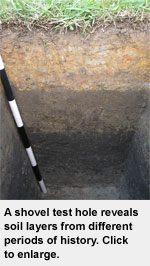 There have been several historic pieces discovered. The first day of the project uncovered a piece of Brown Salt Glazed stoneware pre-dating 1775 and fragments of free-blown olive green glass possibly also from the colonial period.
There have been several historic pieces discovered. The first day of the project uncovered a piece of Brown Salt Glazed stoneware pre-dating 1775 and fragments of free-blown olive green glass possibly also from the colonial period.
“All these are tantalizing signs of the missing chapters of early colonial history in this region, but much more work remains,” Worth said.
Worth hopes to find remains of the village fairly intact; he said that evidence indicates that the immediate area he is searching has never been plowed or farmed. His students dig small test holes, noting their exact location via GPS and logging the contents, if any, found in the hole. It’s a slow careful process, with small scoops of dirt shaken through a screen to collect any items that might be hidden.
Last week, as the students moved from residential backyards into a thickly wooded area closer to the river, shovel tests found small pottery fragments believed to have dated between 1,000 and 2,500 years ago — the first ever prehistoric evidence of occupation in North Escambia.
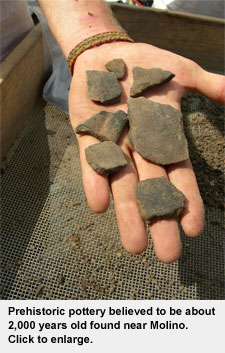 This past Friday, the UWF students uncovered a small concentration of Native American pottery sherds that appear to be from the 18th-century, several lead shot pellets consistent with those found at Spanish presidios in that period, more lead shot pellets and other items including a melted lump of copper or brass.
This past Friday, the UWF students uncovered a small concentration of Native American pottery sherds that appear to be from the 18th-century, several lead shot pellets consistent with those found at Spanish presidios in that period, more lead shot pellets and other items including a melted lump of copper or brass.
They also found more prehistoric pottery, evidence dating to the first millennium A.D., of settlements along the modern-day Escambia River in Molino.
NorthEscambia.com will continue to follow the search for Mission San Joseph De Escambe near Molino, and we will keep you updated over the next few weeks. We will have more photos from the site, and we will let you know what the archaeologists find.
Click here for more photos from the dig site.
Editor’s Note: While we have mentioned that the archaeological dig is in the Molino area of North Escambia, we are not revealing the exact location at this point. It is all on private property (public access would be trespassing), and UWF wishes to protect the area until their work is done and to not compromise the integrity of any artifacts that might be in the area. Once the project is complete, we will publish an article with the exact location of the dig.
Pictured above: UWF Archeology students carefully sift through soil while search for artifacts near Molino. Pictured below: A piece of possibly 19th century pottery that was found during our visit. NorthEscambia.com photos, click to enlarge.
Comments
15 Responses to “UWF Digging For The Past In Molino; 2,000 Year Old Artifacts Found”



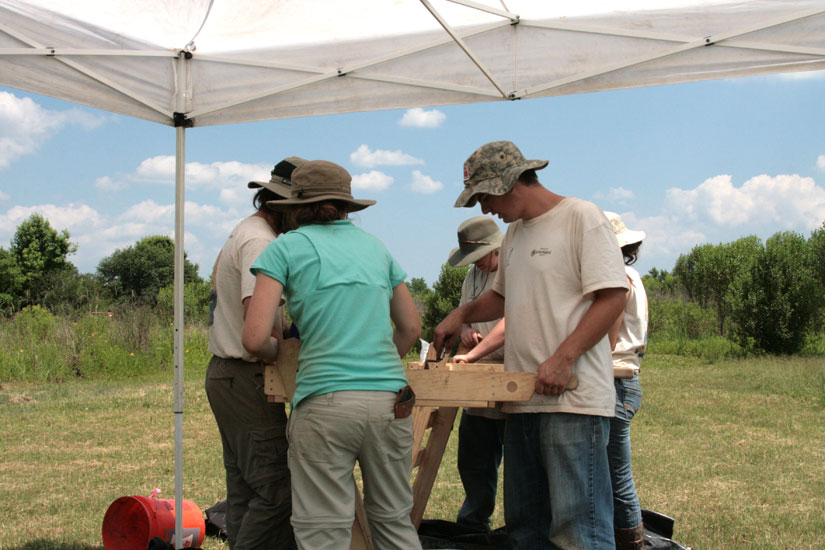
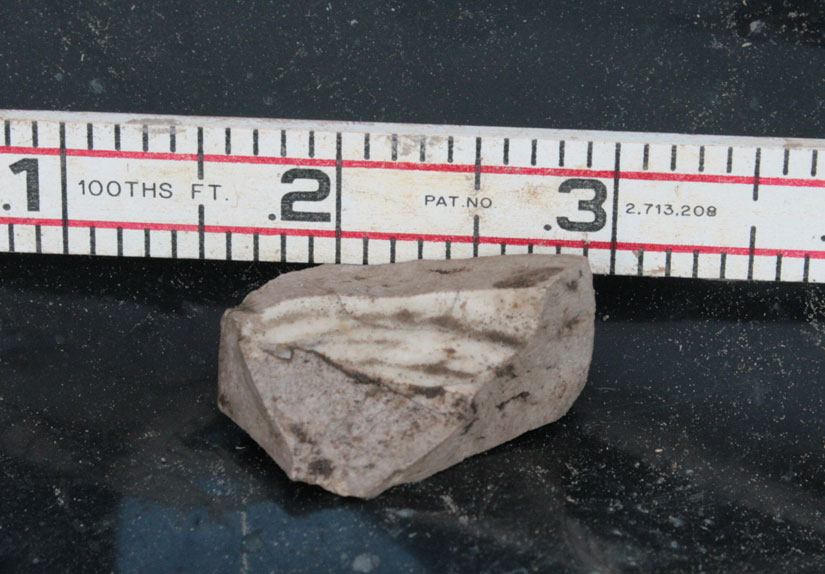
I am somewhat of a history buff and love anything archaeology. Have studied the area from Pensacola to Pollard ( mostly during the Civil War). I understand that many years ago two treasure hunters detected all the areas between Hwy 29 and the Escambia River. I heard also that they left no stone unturned. I am also ametal detector/ hunter and would like to be involved in any digs/searches for any era. Would someone contact me about how to get involved. Would appreciate any assistance and would help in any way possible. I am also a good researcher and will help with research . I liv e in the Century area and retired. Thanks
great reading. being of Aplachee Indian blood here in Louisiana it would be great to be able to come an help find these artifacts, Our tribe is of the tribe forced from florida.
It’s incredible what you all are doing. In fact I envy you!
I wish you many wonderful finds and items that will tell you of that areas history.
So hoping you may be able to offer me assistance.
Several years ago I found three very interesting items in and near the river where I played as a child. Matter of fact 40 some years ago I had an entire shoebox full of indian arrow heads.
My problem, I am having trouble locating someone to determine the age of my items and exaztly what all are.
Could you possible help or point me in a GOOD direction?
I can send photographs email.
Thank you for any consideration.
Louretta Pugh
My grandfather, Alvah J. Moore, hailed from Molino and used to sing songs about the Perdido. He left the area in the early 1900’s after the sawmills shut down.
I was wondering if anyone has put together a history of the area from around the 1830’s till 1900, and if so, would they share it? I can be reached at sheilabr@msn.com
I Dont Care Who You Are This Stuff Is Very Interresting. I’m Just A Kid and All but I Love Learning About History Especially When I Grew Up Around There. Can’t Wait To See More Pics Of What They Find.
This is very interesting, I was just speaking to my huband on the subject about the old molino jail behind the Molino Lodge and also about when I was a child ,my Grandfather always told us children stories of an Indian burial ground off Fairground road really close to Escambia river. I think it is now Fillingim road my brothers and sisters used to play with friends here years ago ,a family lived at the end of this road Carnley was the last name . I would like to know if anyone in this era would also have the same story my Grandfathers name was Jessie Lee Ward Sr. you know this is alot of history about Molino. Also I would like to know if anyone has heard any plans to utilize the old Molino Elementary School Building in the future,does the County still own this prpoerty? if so couldn’t they at least clean it up a little bit . There are also alot of memories there too. or have a community cleanup Day !!!!just a suggestion
The logistics would be crazy, but I wish that some kids from the local schools could somehow be involved in discovering the history of this region.
Regarding the reference to the Chiscas; from Wikipedia “The Chisca were a tribe of Native Americans living in eastern Tennessee and southwestern Virginia in the 1500s. They were encountered by both the Hernando de Soto Expedition in 1542 and the Captain Juan Pardo Expedition in 1568. A small exploration party sent out by de Soto in the vicinity of the upper Tennessee River was defeated by Chisca soldiers.[1] The experience influenced de Soto to limit explorations in Chisca territory . . .” http://en.wikipedia.org/wiki/Chisca
It is more likely that the early Spanish who had been so soundly defeated by the Chisca in Tennessee regarded the land north of Pensacola as belonging to the “Chisca”, and so the river flowing out of the north became the “River of the Chiscas” or “Rio del Chiscas”, when the Creeks (albeit a bit later) called the river the Conecuh or the River of Reeds or Cane River.
Interesting!
I found a map at the Library of Congress (and have a copy of it) that dates to the mid-1700’s. The map clearly shows and is carefully annotated depicting a Spanish fortress/mission/trading post just south [2 Leagues distance by the map] of present day Century on the Escambia River. It is near what is marked and depicted as an Indian Corn Plantation on the Santa Rosa County side of the river. I also have a satellite photo of the area of the Fort that shows the exact location in a man’s field. The things that make you go “Hmmmmmmmm . . .”
Artifacts are always found near old water sources. Most people will step right over old pottery sherds like those, not knowing what they are.
I grew up in the Northwest FL area by Perdido River & Brushy Creek and I used to find what I considered to be “rocks” that looked a lot like these pieces that are being called pottery. I also found pieces shaped like arrowheads similar to the piece shaped like an arrowhead in these pictures. It would be interesting to know how they determined this to be pottery and not rock pieces.
I love archaeology, but am a far cry from being an archaeologist!!
The pottery looks a lot like the pottery we found back in the 1970’s and 1980’s. Along with the pottery we found shell middens and human bones. UWF conducted a dig at the site and determined that it was also around 2,000 years old. We found the items on the Escambia river, between Jay and Century.
This is so exciting. This kind of school sounds like something I would enjoy if younger. The heat would forbid it now. I hope we hear more, soon. Thanks for the story and the pictures.
Fascinating!!! Thanks for covering this. And please keep us up to date.
This find would be very interesting.
Go Argos!